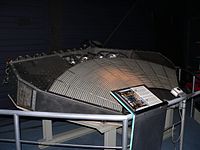Calorimeter (particle physics)

Imagine you have some cookies that you want to find out how many calories they have. You can't just eat them and guess, right? That's where a calorimeter comes in handy!
A calorimeter is like a special tool that scientists use to measure how much energy (in the form of heat) is released when things are burned or exploded. In particle physics, scientists use calorimeters to measure how much energy particles have.
So, when a particle goes into a calorimeter, it passes through some material that absorbs all its energy and causes it to "explode" (similar to how a cookie would "explode" in your stomach when you eat it). This explosion creates heat, which is then measured by the calorimeter.
By measuring the amount of heat created by the particle, scientists can figure out how much energy the particle had originally. This helps them understand more about the particle and how it interacts with other particles.
Overall, a calorimeter is a special tool that helps scientists measure the energy of particles by measuring the heat they release when they are absorbed. It's like using a special oven to find out how many calories are in your cookies!
A calorimeter is like a special tool that scientists use to measure how much energy (in the form of heat) is released when things are burned or exploded. In particle physics, scientists use calorimeters to measure how much energy particles have.
So, when a particle goes into a calorimeter, it passes through some material that absorbs all its energy and causes it to "explode" (similar to how a cookie would "explode" in your stomach when you eat it). This explosion creates heat, which is then measured by the calorimeter.
By measuring the amount of heat created by the particle, scientists can figure out how much energy the particle had originally. This helps them understand more about the particle and how it interacts with other particles.
Overall, a calorimeter is a special tool that helps scientists measure the energy of particles by measuring the heat they release when they are absorbed. It's like using a special oven to find out how many calories are in your cookies!
Related topics others have asked about:
